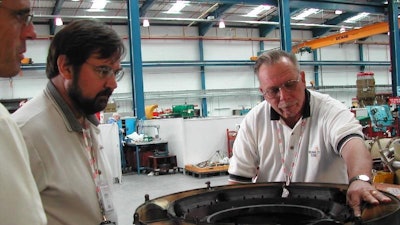
In order to know if all Root Cause Analysis (RCA) is the same, we first have to define what RCA really means. On the surface this seems quite simple, but unfortunately it is quite complex. When I train or present speeches around the world, I often poll my audiences about how they define RCA, and I will get as many different answers as I have people that I ask.
This is unfortunate because there is no universally accepted definition of what RCA actually is. Are there definitions out there? Absolutely; there are hundreds of them! Various regulatory agencies have their own such definitions, as do corporations and companies. However, when definitions differ between agencies, corporations and industries, it is hard to measure the effectiveness of RCA across the board, because everyone considers whatever they are doing as RCA.
A few examples of this are when we use RCA as a noun and therefore all different brands and techniques are just adjectives describing the noun. In Figure 1 we prove this by providing definitions of analytical methodologies that are often grouped into the category of RCA.
I will add another potential form of RCA considered by many, which is “trial and error.” I do not list it with the others because I really don’t consider it an analytical process. This approach just supports the paradigm of ‘if it ain’t broke, don’t fix it!’ This is more akin to applying a crisis maintenance strategy – there really is no analytics going on; we just fix things when they break.
Figure 1
Let’s expand a little on each of these processes to bring them to our workplaces.
1. Troubleshooting. When something fails in our workplaces, do faces come to mind of the people that we immediately turn to, to make everything alright? These are the heroes who get us back to normalcy quickly, and they get a fair amount of recognition for doing so.
However, these individuals are being provided positive recognition for being great responders. They are rarely doing any analytics to understand root causes, but they are great at implementing temporary solutions. A progressive management team, under these conditions, would be asking, “Why is this guy getting so much practice in responding?” That’s where the meat is. This approach is normally attractive because it is quick, inexpensive and demonstrates immediate action.
2. Brainstorming. We can all relate to this analytical technique. Something bad happens, we put very smart people in a room who listen to a summary of what we know happened (the bad outcome). Oftentimes this description embeds hearsay as fact, and the group is accepting of this hearsay as they move on to solutions; people throw out disconnected ideas as to what they think happened, and then they move on to action plans.
Usually this approach focuses on speed to demonstrate activity, and as a result is weak on evidence and analysis down to root causes. Chances are this team will be meeting again because the failure will recur. This approach takes a little longer because we are not dealing with an individual, we are dealing with several individuals so it requires more give-and-take in discussions.
3. Problem Solving. This approach is very common and is essentially brainstorming plus a structured analytical tool like 5-whys or a fishbone diagram. The tool provides a degree of discipline as it has a series of steps and a structure to follow. This is certainly more progressive than troubleshooting and brainstorming and, when applied properly, could be effective. However, in my 30+ years of this business, I find that this approach is not always applied properly. People are usually operating under time constraints and therefore the time to collect evidence is expensed. So we run with hearsay and assumption, we treat them as facts, and we develop and implement recommendations accordingly.
4. Root Cause Analysis. The bedrock of any effective RCA methodology and tool will be:
- The proper defining of a factual problem statement.
- The requirement of collecting hard evidence to back up our hypotheses.
- The utilization of a cause-and-effect tool, versus a ‘categorical’ tool. Categorical RCA tools employ the use of broad cause categories (i.e. – Man, Machine, Methodology, Communications, etc.) and they require brainstorming underneath that category for more specifics. Cause-and-effect tools like a Logic Tree require logic be correlated to each other, while evidence is proving the hypotheses that are true. This essentially is a graphical reconstruction of the failure being analyzed. For more information on a comparison of these approaches using a common case study please click here.
- Drilling down past the decision-maker and focusing on flawed management systems that influenced poor decision-making.
- The development and implementation of effective corrective actions and the tracking and trending of quantifiable bottom-line metrics demonstrative of improvements on the front lines.
- Emphasis on creating an overall corporate knowledge management system that leverages successful logic and puts it at the fingertips of others that can use it, all around the corporation.
Time pressure has a huge impact on the effectiveness of an RCA. When anyone is time pressured to do anything, they often will take short-cuts. In the RCA world, the shortcuts are likely to take place from the most time-consuming part of an analysis/investigation – the data collection phase. So when we take short cuts on gathering our evidence, we increase the risk of recurrence because we are not operating on facts, just hearsay and assumptions. Figure 2 will demonstrate the correlations that time pressure has on analysis effectiveness and accuracy.
Figure 2
In summary, the faster we do an analysis, the more likely we are to do the same analysis again. This is because we are likely to be weak on evidence and our focus is on solutions and not analysis. On the surface, the advantages of ‘shallow cause analysis’ tools are that they are faster and require fewer resources to complete the analysis. The disadvantages are that we are likely to repeat the need to do another analysis on the same issue.
When RCA is done properly, it does take more time to conduct an effective analysis. However, we should not have to do it again if we did it right the first time!
Remember, “We NEVER seem to have the time and budget to do things right, but we ALWAYS seem to have the time and budget to do them again!”
For case study summaries from those who have done it right the first time, please view their stories demonstrating proven ROIs ranging from 1,000% to 17,900% (there is no typo!). https://reliability.com/
Robert J. Latino is CEO of Reliability Center, Inc. Mr. Latino and been a practitioner, trainer, author and international speaker on the topics of Reliability and Root Cause Analysis for over 30 years. He can be contacted at 800/457-0645 or [email protected]. Visit our website at www.reliability.com to learn more.






















